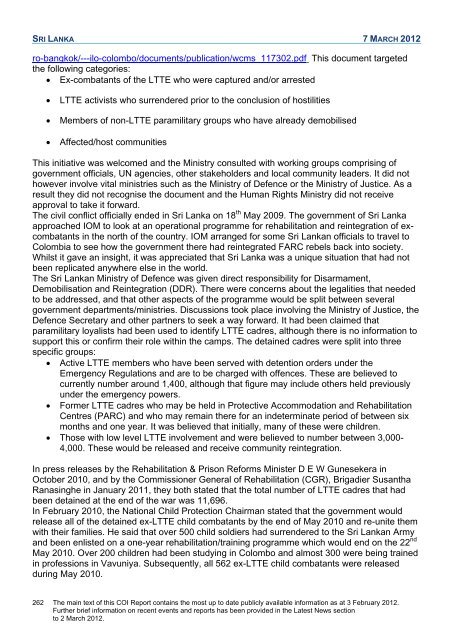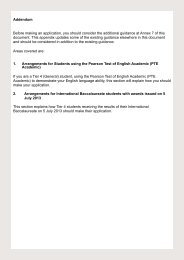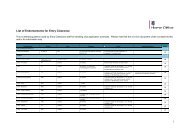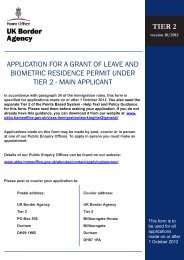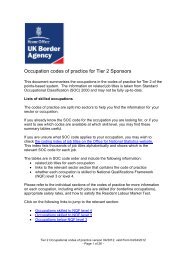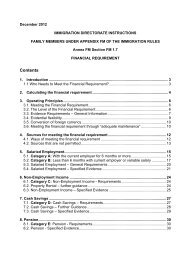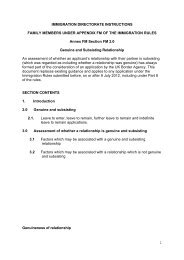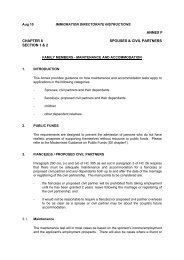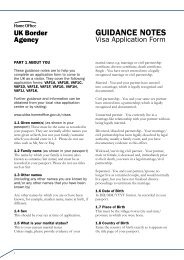COI Report March 2012 - UK Border Agency - Home Office
COI Report March 2012 - UK Border Agency - Home Office
COI Report March 2012 - UK Border Agency - Home Office
You also want an ePaper? Increase the reach of your titles
YUMPU automatically turns print PDFs into web optimized ePapers that Google loves.
SRI LANKA 7 MARCH <strong>2012</strong><br />
ro-bangkok/---ilo-colombo/documents/publication/wcms_117302.pdf This document targeted<br />
the following categories:<br />
� Ex-combatants of the LTTE who were captured and/or arrested<br />
� LTTE activists who surrendered prior to the conclusion of hostilities<br />
� Members of non-LTTE paramilitary groups who have already demobilised<br />
� Affected/host communities<br />
This initiative was welcomed and the Ministry consulted with working groups comprising of<br />
government officials, UN agencies, other stakeholders and local community leaders. It did not<br />
however involve vital ministries such as the Ministry of Defence or the Ministry of Justice. As a<br />
result they did not recognise the document and the Human Rights Ministry did not receive<br />
approval to take it forward.<br />
The civil conflict officially ended in Sri Lanka on 18 th May 2009. The government of Sri Lanka<br />
approached IOM to look at an operational programme for rehabilitation and reintegration of excombatants<br />
in the north of the country. IOM arranged for some Sri Lankan officials to travel to<br />
Colombia to see how the government there had reintegrated FARC rebels back into society.<br />
Whilst it gave an insight, it was appreciated that Sri Lanka was a unique situation that had not<br />
been replicated anywhere else in the world.<br />
The Sri Lankan Ministry of Defence was given direct responsibility for Disarmament,<br />
Demobilisation and Reintegration (DDR). There were concerns about the legalities that needed<br />
to be addressed, and that other aspects of the programme would be split between several<br />
government departments/ministries. Discussions took place involving the Ministry of Justice, the<br />
Defence Secretary and other partners to seek a way forward. It had been claimed that<br />
paramilitary loyalists had been used to identify LTTE cadres, although there is no information to<br />
support this or confirm their role within the camps. The detained cadres were split into three<br />
specific groups:<br />
� Active LTTE members who have been served with detention orders under the<br />
Emergency Regulations and are to be charged with offences. These are believed to<br />
currently number around 1,400, although that figure may include others held previously<br />
under the emergency powers.<br />
� Former LTTE cadres who may be held in Protective Accommodation and Rehabilitation<br />
Centres (PARC) and who may remain there for an indeterminate period of between six<br />
months and one year. It was believed that initially, many of these were children.<br />
� Those with low level LTTE involvement and were believed to number between 3,000-<br />
4,000. These would be released and receive community reintegration.<br />
In press releases by the Rehabilitation & Prison Reforms Minister D E W Gunesekera in<br />
October 2010, and by the Commissioner General of Rehabilitation (CGR), Brigadier Susantha<br />
Ranasinghe in January 2011, they both stated that the total number of LTTE cadres that had<br />
been detained at the end of the war was 11,696.<br />
In February 2010, the National Child Protection Chairman stated that the government would<br />
release all of the detained ex-LTTE child combatants by the end of May 2010 and re-unite them<br />
with their families. He said that over 500 child soldiers had surrendered to the Sri Lankan Army<br />
and been enlisted on a one-year rehabilitation/training programme which would end on the 22 nd<br />
May 2010. Over 200 children had been studying in Colombo and almost 300 were being trained<br />
in professions in Vavuniya. Subsequently, all 562 ex-LTTE child combatants were released<br />
during May 2010.<br />
262 The main text of this <strong>COI</strong> <strong>Report</strong> contains the most up to date publicly available information as at 3 February <strong>2012</strong>.<br />
Further brief information on recent events and reports has been provided in the Latest News section<br />
to 2 <strong>March</strong> <strong>2012</strong>.


